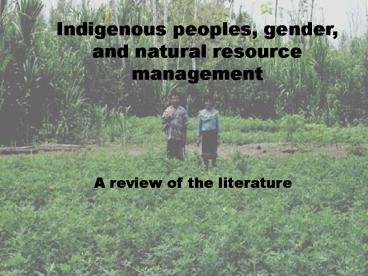Indigenous peoples, gender, and natural resource management PowerPoint PPT Presentation
1 / 17
Title: Indigenous peoples, gender, and natural resource management
1
Indigenous peoples, gender, and natural resource
management
A review of the literature
2
Search results (DCISM)
376
6 (76)
22
0 (7)
3138
231 (4138)
16 (181)
Natural Resource Management
(Environment)
3
Types of literature on IP, Gender and NRM
- Policies, strategies and project evaluations
- Academic literature (Anthropology, ethnobotany,
law, NRM, WED/GED)
4
Indigenous women
- Doubly oppressed
- Doubly idealized
- Doubly invisible
5
Indigenous peoples and natural resource
management
- Gender blind
- IP manage natural resources
- Indigenous natural resource management is
embedded in cultural and spiritual values and
knowledge
6
Findings from WED and GED
- Men and women have different access to and
control over natural resources and other means of
production - Men and women use different natural resources and
ecosystems or use the same differently - Men and women have different needs and priorities
- Men and women have different knowledge of natural
resources - Men and women are affected differently by
environmental degradation and restrictions.
7
Indigenous gender relations
- Gendered division of labour
- Male (research) bias
- Gender flexibility and complementarity
8
Research topics
- The role of indigenous women in NRM
- Indigenous womens importance for the
conservation of biodiversity - Indigenous women's specific knowledge and use of
NRM
- IP gender relations and change
- The impact of modernization and environmental
degradation on IP women's status and situation
9
Research findings
10
Gendered knowledge and use
- Indigenous men and women have different
site-specific knowledge and use - Indigenous men and women have different
species-specific knowledge and use - Indigenous men and women have different
priorities with regards to the use of natural
resources and also different possibilities
11
Indigenous gender relations and change in NRM
- Tendency for indigenous women to loose access to
and control over resources as part of the
modernization process, and to become economically
dependent on their husbands.
12
Conclusions
- Indigenous women play a vital role in indigenous
natural resource management - Indigenous womens natural resource management
enhance and conserve biodiversity - Gender-blind interventions have gendered
consequences
13
Research weaknesses
- Many descriptions - but lack of analysis and
recommendations for intervention - Much literature on IP and NRM remains gender
blind - Much literature on NRM and gender remains
ethnicity blind - Lack of a genuine gender approach women are
still the only gender - Tendency to reproduce stereotypes and rigid
dichotomies
14
Extraction of practical findings
15
Constraints
- Gender strategies are not followed up with
workable guidelines the concept is not really
understood. - Project staff lack training and/or dedication
- Local resistance from men and authorities make it
difficult to ensure equal participation of men
and women. - The fact that indigenous women are often
monolinguals and illiterate makes it more
difficult to include them. - Indigenous women are already overburdened by
daily tasks and have limited time for
participation.
16
Recommendations
- The concept of gender should be clearly defined,
agreed upon by all stakeholders and made
operational - All project staff should be trained in gender
analysis - A context specific gender assessment should be
undertaken before planning of the project - Both men and women should be engaged in all
stages of the project cycle. - One person should be made responsible for the
implementation of the gender strategy. This
person should be truly dedicated and have
authority. - Participation does not equal consent! Many
examples of women being included to meet
requirement but without being taken seriously.
But legal and/or donor requirements about equal
participation of both men and women provide a
starting point as it gives women a platform for
gaining visibility. - In order for women to take advantage of this
platform they should be empowered through
training and by making visible women's role
their traditional skills and knowledge. - Training in the equal rights for men and women
can be a useful entry point for raising gender
awareness when working with indigenous peoples,
as they are often already used to the discourse
on indigenous peoples rights.
17
Gaps in the literature
- General lack of research dealing with the
interplay of all three subjects - General lack of written evaluations of
success-stories and guidelines based on
experience

